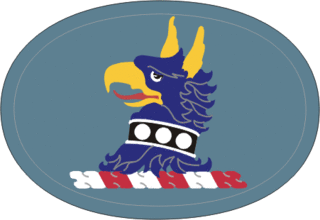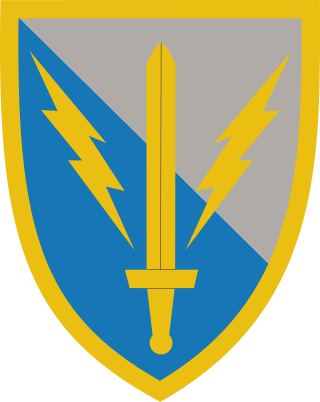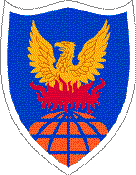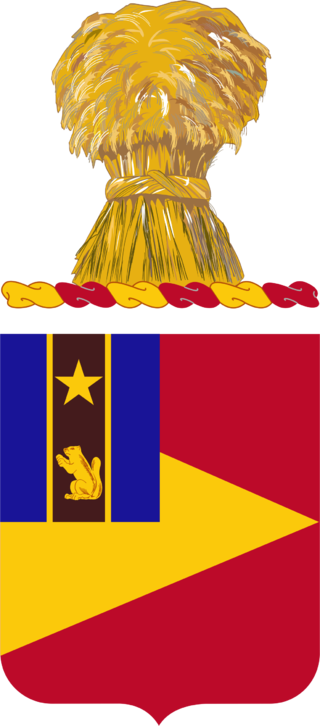
The 93rd Signal Brigade is a unit of the United States Army which was active sporadically from 1941 to the present. Its mission has been to deploy, install, operate, and maintain a global tactical theater communications package, while supporting joint and combined operations. The 93rd Signal Brigade was deactivated on 23 April 2007, and replaced by the 35th Signal Brigade. The Brigade was reactivated at Fort Eustis, Va on 16 July 2008 to support the 7th Signal Command (Theater).
The 198th Signal Battalion is an Expeditionary Signal Battalion in the Delaware Army National Guard. Delaware is known as the "First State," as referenced in their motto "First Regiment of First State." The unit specializes in command post node communications, providing broadband satellite voice and data connections for brigade sized battlefield elements. The unit includes Headquarters, Headquarters Company located in Wilmington, DE; A Company in Georgetown, DE; B Company in Hodges, SC; and C Company in Wilmington, DE. It is one of several National Guard units with colonial roots and campaign credit for the War of 1812.

The Oregon Army National Guard is a federally mandated and equipped military organization under the civilian direction of the Oregon Military Department, with the Governor of Oregon as its Commander-in-Chief. It responds to state and national emergencies, military conflicts and natural disasters, and conducts search and rescue operations. While the history of the militia dates back to the establishment of the first Oregon militia in 1843, the present Guard was not established until after 1903. The modern Guard includes citizen soldiers, and its motto is "When we are needed, we are there."

The 5th Signal Command (Theater) ("Dragon Warriors") was a European-based tactical and strategic communications organization of the United States Army specializing in command and control which supported theater-limited, joint-forces, and combined forces activities. The command's mission was to build, operate and defend network capabilities to enable mission command and create tactical, operational and strategic flexibility for Army, Joint and Multinational forces in the EUCOM and AFRICOM areas of responsibility.

The Delaware Army National Guard is a component of the United States Army and the United States National Guard. National coordination of various state National Guard units are maintained through the National Guard Bureau.

The 37th Infantry Brigade Combat Team (Buckeye) is an infantry brigade combat team of the United States Army National Guard with the brigade headquarters, cavalry squadron, field artillery battalion, engineer battalion, one infantry battalion, and support battalion stationed in Ohio, one infantry battalion and military intelligence company stationed in Michigan, and a third infantry battalion stationed in South Carolina. The headquarters of the 37th IBCT traces its lineage and honors back to the headquarters of the 37th Infantry Division.

The 335th Signal Command (Theater) is an operational and functional U.S. Army Reserve command of more than 4,000 Active and Reserve Soldiers, providing Signal and Cyber units in direct support of the U.S. Army, Army Reserve exercises, and Homeland Defense missions throughout the United States.

The 3rd Signal Brigade of the United States Army was an element of III Corps. It was based at Fort Hood, Texas, but was inactivated on 15 April 2008 as part of the transformation of the U.S. Army to a Modular Force Structure. The 3rd Signal Brigade has a history of inactivations and reactivations ever since formation of the unit in 1946.

The 56th Artillery Command is a two-star command of the United States Army that serves as the Force Field Artillery Headquarters for U.S. Army Europe and Africa, with a mission to synchronize, integrate, and control fires and effects in support of the theater land component. The unit was originally formed on September 14, 1942, as the 56th Coast Artillery Brigade and has been reorganized and redesignated several times until its inactivation on June 30, 1991, following the reunification of Germany and the end of the Cold War.

The 35th Engineer Brigade is a combat engineer brigade of the United States Army National Guard of Missouri based at Fort Leonard Wood.

The 75th Field Artillery Brigade is an artillery brigade in the United States Army. It is currently based in Fort Sill, Oklahoma and supports the III Armored Corps. The brigade is officially tasked to train and prepares for combat; on orders deploys to any area of operations to plan, synchronize and execute combined, and joint fires and effects. Integrate attached ground and air maneuver forces and on order function as a maneuver headquarters in support of full spectrum operations.

The 42nd Infantry Division Sustainment Brigade is a United States Army sustainment brigade of the 42nd Infantry Division of the New York Army National Guard headquartered out of the 369th Regiment Armory in Harlem, New York. This unit is descended from the 369th Infantry Regiment.

The 201st Expeditionary Military Intelligence Brigade is located at Joint Base Lewis-McChord, Washington. The 201st was originally named the 201st Military Intelligence Brigade and on 3 July 2008 it became the Army's third active duty battlefield surveillance brigade and was renamed the 201st Battlefield Surveillance Brigade (BfSB). The US Army decided to get rid of its BfSBs and the 201st was realigned into a new expeditionary military intelligence brigade.

The 211th Military Police Battalion is a unit of the Massachusetts Army National Guard. Its Headquarters and Headquarters Detachment is descended from the First Corps of Cadets, initially formed in 1741. It is one of several National Guard units with colonial roots. Its motto is Monstrat Viam – "It Points the Way." While it has served in five wars, the sub-unit's primary contribution to Massachusetts and to the United States was as an officer-producing institution for new regiments from the Revolutionary War through World War II.

311th Signal Command Theater is the designated signal command for the Army Service Component Commands within the Pacific and Korean theaters. The staff of 311th Signal Command consists of more than 3000 active-duty soldiers, U.S. Army Reserve soldiers and Army civilians. Headquartered at Fort Shafter, Hawaii, the 311th SC(T) and its subordinate units are stationed across 16 time zones, ranging from Alaska to Korea, and from Hawaii to California.

The 133rd Field Artillery Regiment is a parent field artillery regiment of the United States Army National Guard. It is currently represented in the Texas Army National Guard by the 1st, 3rd, and 4th Battalions.

The 197th Field Artillery Regiment is a regiment in the New Hampshire Army National Guard.

The 32nd Army was a formation of the Soviet Army during World War II. The army was formed twice during the war, disbanded as part of the post-war demobilization and then reformed in 1969 to protect the Soviet-Chinese border.

The 94th Cavalry Regiment is a United States Army cavalry regiment, represented in the Minnesota Army National Guard by 1st Squadron, 94th Cavalry, part of the 1st Armored Brigade Combat Team, 34th Infantry Division, stationed at Duluth.



















